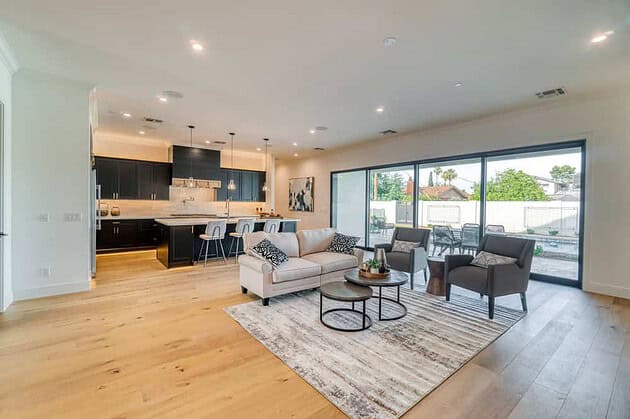Improving the aesthetics of your house or workplace takes time and effort. Things like a new furniture set or a fresh coat of paint are usually the first things that come to mind. However, it would be best to consider an architectural lighting design approach. Consequently, the overall feeling of a well-lit venue encourages a happy and easy atmosphere.
Most individuals don’t give lighting much thought. Because as long as they serve their function, there’s no reason to change them, right? However, the truth is that updating your lighting is a crucial step in making your property more presentable. Proper lighting can enhance its aesthetic appeal while making it safer and more convenient to navigate at night.
Recent research claims that the lighting industry’s total revenue is gradually increasing at a rate of 4.47% yearly. It proves that more and more people are placing more importance on their property’s lighting, whether for appearance or function’s sake.
Therefore, it’s best to think about lighting setups that are up to date. This article will explain how improving your building’s lighting can revitalize its appearance and make it more comfortable to live in or work in. Read on to discover more about the intricacies of architectural lighting design for the home or workplace.

Why Is Lighting Important?
Every room, bathroom, kitchen, and hallway needs a lighting setup. There’s no doubt that natural light significantly affects the human body. However, it’s also prudent to recognize the considerable impact of artificial light. People rely on artificial illumination for several reasons, including improved visibility, navigation, and ambiance.
When used intelligently, interior and outdoor lighting may bring out the best in a building’s design and completely change how people interact. Hence, it’s best to reach out to an expert like Washington Outdoor Lighting or other accomplished firms to ensure the quality of the finished project.
The three stages of perception may help you decide what light fixture or setup will work best in a specific setting. First, focus on an object or feature you want to showcase in your surroundings. Then, sort everything into groups that reflect your vision for the area. You can also put it in a category that illustrates what you think it does best. Finally, use that category to interpret what you’re seeing so you can bring your vision to life.
To use an example for architectural lighting, a poorly lit factory may trigger negative associations because of its similarity to the settings of horror films. On the other hand, you may get a more favorable impression of a factory if it’s well-lit and looks inviting.
The psychological effects of light and its application to architecture depend on different hues. The mood you get from a room can be drastically altered by changing the light’s hue. This is because you subconsciously link particular colors to emotional responses or actions.
For instance, displaying school colors on campus buildings can inspire a sense of pride, whereas displaying the colors of a rival school could cause resentment. The use of colored architectural lighting can also emotionally impact the viewer.
What Are The Three Key Aspects Of Architectural Lighting?
There are three elements to consider to strike a good lighting and architectural balance. Significantly, a high-quality end product must have design elements that prioritize aesthetics alongside function and efficiency.
- Function: Lighting is essential in many ways. It’s vital to ensure that a building’s lighting isn’t just there for show; it should be able to help people see. Safe passage through a room or into a building requires enough illumination of the ground and walls. Doing so generates a sense of security, and people within that room can be calmer and more relaxed.
- Efficiency: Sustainable lighting design is becoming increasingly important in the architectural lighting industry as concerns about environmental health continue to rise. Efficient light-emitting diodes (LEDs) can be used to conserve energy and serve their purpose at the same time.
A well-designed house that maximizes natural light can also make your lighting design efficient. The same can be said for solar panels to power your LEDs for maximum eco-friendliness.
- Aesthetics: Designers and architects pay close attention to how the proper lighting and building features can help create a pleasing look. To do this, they think about how they want people to feel as they enter and explore space.
For instance, lighting in restaurants, bars, or entertainment centers must be functional and aesthetically pleasing. Proper lighting is essential to attracting your ideal clientele since it helps to establish a relaxing and inviting ambiance.
These are the three crucial aspects of architectural lighting. You can consider them when discussing designs with your provider to maximize your chances of having a great lighting setup.
Things To Consider For Your Architectural Lighting System
Several factors can help or hinder your ability to picture how the final lighting installation will appear. A method must be taken while using artificial lighting in building design. For example, consider how different seasons will affect the illumination in your outdoor spaces.
Also, it’s essential to avoid having accent lighting in interior spaces interfere with the primary one. To help you design the optimal lighting system for your building’s specific layout, there are four main factors to consider:
- Cost And Budgeting: There’s a big difference between purchasing recklessly to save money and being smart with your money. Keep that in mind with any investment you’re considering. Hence, choosing an architectural lighting system that will serve its purpose for many years is best.
On the other hand, if you buy cheap equipment or try to set it up on your own, you may pay more for maintenance and repairs each year. Alternatively, you can look for a lighting expert to meet your needs within your budget while providing quality service.
- Overall Appearance: Naturally, investing in architectural lighting is primarily motivated by a desire to improve the visual appeal of your building. It’s important to remember that the colors and temperatures of the lights you use should correspond with the spaces you’re highlighting.
In doing so, it would be wise to consider the object’s surface, the surrounding colors, and the lighting. It would be best to use lighting that blends in with the environment to draw attention to a specific facade or feature.
- Light Source: There’s a difference in brightness between various types of lighting. Light emitted from LED bulbs differs from halogen bulbs. However, low-quality LED bulbs won’t do the same job as high-quality ones.
Choosing the kind of lighting that can give the quality, clarity, and color you desire can be challenging. Hence, it’s necessary to examine the color rendering, light temperature, and other features of the lighting source.
- Smart Control: Modern technologies allow for a wide range of customization options. This means any system you put in your building, including the lights, can be controlled independently.
You can shift the light’s brightness, color, and tone with just one click. So, if you plan on making frequent adjustments to the lighting, you may want to think about a setup that gives you control over each light fixture.
You should have peace of mind if you prepare for these four lighting considerations. Moreover, the real fun begins as soon as you finish installing the lights. However, it’s wise to put money into a lighting system that won’t start showing its age for quite some time.
Benefits Of A Well-Planned Architectural Lighting Setup
The aesthetic value of a room and the ambiance it creates are both affected by the lighting. Hence, a well-lit space is more comfortable for your family, staff, or visitors. When combined with natural light and other forms of illumination, the benefits of architectural lighting may completely change any room.
Below are some benefits one can expect after installing a well-planned lighting project.
Enhanced Security And Safety
Making an area more identifiable can discourage unwanted visitors from entering. It may also prevent accidental trespassing—frequently occurring when someone wanders into an off-limits area because they’re unsure of the boundaries. Architectural lighting, such as track lighting, can be equipped with motion sensors to notify security personnel of any presence.
Accessibility and security are both improved by well-lit indoor and outdoor areas. While an excessive amount of the wrong kind of lighting can be distracting, using just the right amount of light will enhance visibility. Also, architectural accent lighting can provide an additional layer of visibility, allowing people to move around in a more secure environment.
Eye-Catching Establishment
Providing enough light to make an area noticeable is the primary goal of any lighting system. Therefore, having your building well-lit with artificial lighting will make it easier for customers to find you.
Displaying your building and grounds to the public shows that you value appearance as much as the quality of your services and staff. The same idea applies to attracting new customers and clients to your business: more eyes on your business means more opportunities.
Assists In Functionality
The visual value of a building can be further enhanced by adequately illuminating its public spaces. Some ergonomic requirements are functional—such as the desire for enough lighting in a parking garage. However, when it comes to natural light, aesthetics and functionality often go hand in hand when constructing an ergonomic lighting plan.
If you’re a business establishment that needs proper lighting, you may lose sales due to the lack of lights alone. It’s best to reach out to the experts and ask for their opinion. They can give you different insights and help you decide.
Takeaway
Lighting in buildings is as crucial as designing them. The strategic use of lighting, color, and texture can alter your mood and impression of a room. Lighting, whether natural or artificial, helps you take in the beauty of buildings by highlighting details you might have missed otherwise.















